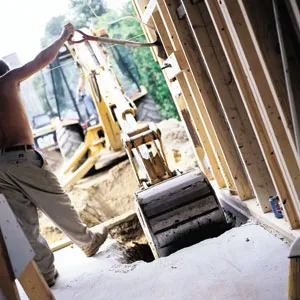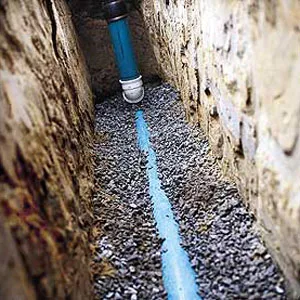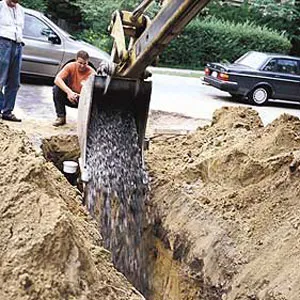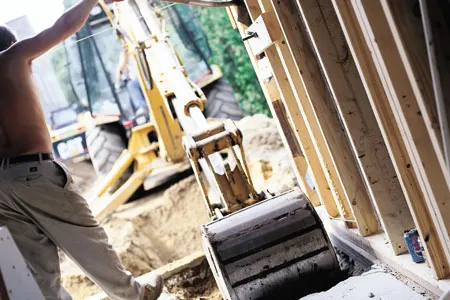
Like a master puppeteer, John Aiello sits in the cab of his excavator and manipulates hydraulic levers that control a backhoe arm extending 20 feet ahead of him. As a police officer redirects oncoming traffic, he quickly carves a trench 7 feet deep into the street in front of Janet and Jeff Bernard’s 1894 Shingle-style house in Concord, Massachusetts. Somewhere far under the layers of asphalt and soil lies the sewer main — an 8-inch-wide clay pipe that Aiello, a foreman for an excavating company, needs to connect to the barn in the Bernards’ backyard, which This Old House is converting to an in-law cottage for the current TV project.
The sewer line will be just one of several new systems installed to serve the modest outbuilding that the Bernards are making into a residence for Janet’s parents. Before TOH general contractor Tom Silva can turn this former chicken shack into a snug cottage, he needs to bring in all the basics: sewer, water, gas, and electric — not to mention high-tech necessities like telephone, cable, and Internet lines.

A Complex Network
Most people don’t give much thought to this labyrinth of essential services until they build a new home or — like the Bernards — convert an outbuilding that has no systems, save antiquated, exposed electrical wires for a few lights. In recent years, tying into those systems has become more complex and expensive; the Bernard hookup will cost around $30,000. One reason is the trend toward running wires underground. This avoids unsightly utility poles and the chance that storms can knock out power, but it costs much more to dig than to string a wire. Another complicating factor is the proliferation of high-tech services, each of which runs through its own plastic pipe.
It would be easier — and much cheaper — if all those systems could be buried in one neat trench, but safety and performance dictate otherwise. Consider water and sewer lines, which typically need to be 10 feet apart (codes vary), with the sewer line always below the water line; in the unlikely event that a sewer pipe and a water pipe both spring leaks, the sewage can’t seep down and contaminate the drinking water. Likewise, the phone company prefers its wire be at least 12 inches from the electrical feed to avoid creating static.
Plotting this jigsaw puzzle involves a subterranean task force of tradesmen and utility workers, supervised by a general contractor. The man on the ground — or under the ground — is a specialized water and sewer contractor, who has the know-how, equipment, and insurance to dig trenches for most utility lines, including power and communications. He’s hired by the general contractor — in this case, Tom — to work hand-in-hand with the utility companies’ technicians and the homeowners’ electrician and plumber. “I’m pretty handy with a backhoe,” says Tom. “But having an expert who is fast and accurate, like John is, saves the homeowners a lot of time and money.” The water and sewer contractor also coordinates with a one-call center, such as Dig Safe, which locates and marks the various underground wires and pipes so Aiello knows where to dig — and where not to.

Laying the Pipes
It doesn’t take long for Aiello to locate the sewer main. “If you have enough experience, you can actually feel a little bit of tension as the bucket makes contact with the pipe,” he says. A few feet away, he’s cut another trench to access the water main, an 8-inch cast iron pipe located 4½ feet down — just below the frost line. (The gas company has already run its own line from the street to the driveway.)
To link these public mains with the ones he’ll install on the Bernards’ property, and to create channels for all the systems to reach the barn, Aiello then has to rip up 170 feet of asphalt driveway. It will take him two days to dig the water, sewer, and gas trenches and bring the pipework back to the barn. At the same time, he’ll also dig an additional, 18-inch-deep trench for three empty PVC pipes. Later, electrical contractor Allen Gallant will return to snake electrical and communication wires through them. Flexible plastic gas lines live 3 feet down in their own trench, buried with a “tracer” — a copper wire that can be located with a metal detector in an emergency.
At the other end of the driveway, TOH plumbing and heating expert Richard Trethewey and the Trethewey Brothers Plumbing crew will be back to finish the water, sewer, and gas hookups. Building code dictates that a licensed plumber take over the piping within 10 feet of the house, so when Aiello gets within spitting distance he’ll hand the baton to master plumber Ronnie Coldwell. The plumbing crew will coordinate boring holes through the 10-inch foundation wall (with yet another sub, who specializes in concrete cutting) and mapping out the plumbing and gas lines through the barn’s walls and floors.
The path of least resistance through the barn is a puzzle the crew has yet to piece together, pipe by pipe. They’ll have to dig grooves in the concrete slab floor and find room to run the plumbing in the walls without forcing Tom to build a lot of chases and soffits to hide the pipes. But for now they at least know where it all begins. “We’re going to bring everything into the north corner under the new stairwell, where we can tie into the utility room,” says Richard.
By the time they’ve made their entrance, Aiello will have backfilled the driveway with dirt so Tom and his crew can get back and forth to the street. But even then he won’t be finished; after the barn conversion is completed, he’ll come back and pave the driveway with asphalt — icing on the cake. By then, like most homeowners, the Bernards will have long forgotten what’s going on underneath.
Where to Find It
Architect
Holly Cratsley
AIA
Principal
Nashawtuc Architects, Inc.
Concord, MA
Landscape Architect
Stephanie Hubbard
RLA
Halvorson Design Partnership
Boston, MA
Excavation Contractor
James M. McLaughlin, Inc.
Lexington, MA
718-862-4851
Electrician
Allen Gallant
Gallant Electric
Lexington, MA
718-862-4636

